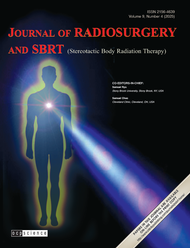- Home
- Journal Contents Downloads
- JRSBRT Downloads
- JRSBRT 9.4, p. 295-303
Product Description
After payment has been processed for your order of a digital copy (PDF) of this article, you will see a download link on your completed order page and also receive an email containing a download link. The links, which will enable you to download one copy of the article, will expire after 24 hours.
Optimizing Gamma Knife radiosurgery: Analysis of gains achieved through upgradation of technology
Arun Thimmarayappa, Nishanth Sadashiva, Subhas Kanti Konar, Abhinith Shashidhar, Vikas Vazhayil, Prabhuraj A R, Manish Beniwal, Arivazhagan Arimappamagan, Dwarakanath Srinivas, Harsh Deora, Bhanumathy Govindaswamy, Gyani Jail Singh Birua, Ponnusamy Natesan, Jeeva Balakrishnan and Nandakarthik Govindarajan
Introduction: Gamma Knife radiosurgery (GKRS) using the 4C system faces challenges with treatment cancellations due to clearance issues, frame complications, and limited treatment space. Understanding cancellation factors is crucial for optimizing patient selection and workflow, particularly with technological advancements in newer systems.
Aims and objectives: This study analyzed the factors associated with treatment feasibility and cancellation in Gamma Knife 4C (GK4C) radiosurgery and explored potential benefits of upgrading to Gamma Knife Icon (GKI) technology, incorporating evidence on clearance mechanisms and treatment improvements.
Materials and Methods: A retrospective analysis was conducted on 108 consecutive patients planned for GK4C treatment between 2006 and 2020. Data on demographics, tumor characteristics, treatment parameters, and reasons for cancellation were collected. Statistical analyses examined associations between variables and treatment feasibility. Hypothetical GKI plans assessed potential improvements. A PubMed review identified 69 studies that addressed treatment cancellation and technological improvements.
Results: The main reasons for GK4C cancellation were clearance issues (41.7%), high organ-at-risk doses (35.2%), and large target volumes (23.1%). Associations were found between reason for cancellation and tumor volume, diagnosis, location, and prescribed dose. Multivariate analysis showed skull base and peripheral lesions had higher odds of clearance issues. Literature confirms that frame distortion, limited space, and inadequate collision detection are primary GK4C system limitations. GKI plans demonstrated improved target coverage and reduced organ-at-risk doses.
Conclusion: Clearance is a major limitation of GK4C radiosurgery, particularly for certain tumor locations and volumes. Literature supports that GKI technology improves treatment feasibility through frameless options, cone-beam CT guidance, enhanced collision detection, and improved stability.
Keywords: Gamma Knife radiosurgery, treatment cancellation, clearance issues, Icon technology, radiosurgery feasibility, collision detection
 Loading... Please wait...
Loading... Please wait...








